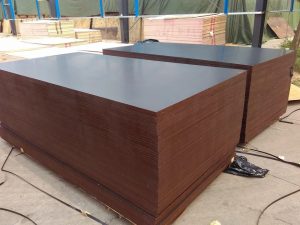Knowledge points about plywood, series one
- What is wood-based panel? Why to develop wood-based panel industry?
Wood-based panel is made of wood or other plant fibers as raw materials, processed and separated into various unit materials through a special process, and then pressed under certain conditions with or without adhesive.
The reason:
1) Improved wood properties: the use of wood is restricted by anisotropy, natural defects and diameter class;
2) Improve the utilization rate, save resources, reduce the requirements on wood materials, make full use of processing leftovers, etc.;
3) Expand the use and added value of wood, small wood, low grade wood modified, reassembled and processed into veneer laminated wood, particleboard and other wood-based panels to replace wood use. - Briefly describe the production methods of wood-based panels.
Wood-based panel production methods can be divided into three categories according to the moisture content of the component unit when the slab is formed: dry method; Wet; Semi-dry method. According to the slab is heated and not heated when pressing the finished product, it can be divided into cold pressing method and hot pressing method. - What are the basic properties of wood-based panels?
(1) Appearance performance: product size and deviation, warpage, material defects, processing defects, edge straightness, two diagonal difference, etc.
(2) Internal properties: including physical properties, mechanical properties, durability, surface characteristics and special properties of wood-based panels.
A. Physical properties: moisture content, density, water absorption, water absorption thickness expansion rate, free formaldehyde release.
B. Mechanical properties: bonding quality, static flexural strength, elastic modulus, internal bonding strength. - Briefly describe the composition principles of wood-based panels.
(1) Symmetry principle: the units in the corresponding layer on both sides of the symmetrical center plane of wood-based panel should have the same tree species, thickness manufacturing method, texture direction and water content.
(2) The principle of interlayer texture arrangement: at right angles or a certain Angle to reduce anisotropy, fiber arrangement direction in the same direction, to play the longitudinal strength dimensional stability characteristics.
(3) Odd number layer principle: when assembling blanks, the principle of symmetry is not followed, the principle of interlayer texture is generally followed the odd number principle - Write the process flow of plywood production by dry heat method.
Log – truncation – peeling – veneer – shearing – veneer drying – splicing – repair – glue and billet – hot pressing – trimming – sanding – inspection and grading - What is plywood? Briefly describe the characteristics of plywood.
Plywood by three layers or more than three layers of veneer according to the principle of symmetry, adjacent layer of wood grain direction perpendicular to each other group blank gluing board. Usually the plate and the inner plate are arranged on both sides of the central layer or plate core.
Characteristics (compared with wood) : 1, high strength to weight ratio, 2, large width, 3, beautiful appearance, 4, anisotropy reduced, 5, retain the advantages of natural materials, hidden part of the defects. - Plywood according to the use, number of layers, the water resistance of the rubber layer is divided into which kinds? According to use: ordinary plywood (non-special plywood, the most output, the most widely used, the most typical structure of plywood), special plywood (with special properties, such as flame retardant, anti-corrosion, insect-resistant plywood) according to the number of layers: three layers of plywood, five layers of plywood, multi-layer plywood according to water resistance: Class ⅰ plywood (weather-resistant plywood, used in outdoor conditions, can pass the boiling test), Class ⅱ plywood (water-resistant plywood, used in wet conditions, can pass the hot water impregnation test at 63± 3℃), Class ⅲ plywood (moisture-resistant plywood, used in dry conditions, can pass the dry test)
- What are the production methods of plywood?
Wet heat method (has been eliminated) : the rotary cut veneer is hot pressed without drying, easy to bubble, stratification, warping, can not use urea formaldehyde glue, bean glue.
Dry cooling method: veneer after drying glue, pressure at room temperature, such as dry gum, latex. Dry heat method: after the veneer is dried, glue is applied and pressed, and some thermosetting glue is used. - What are the requirements of wood raw materials for plywood production?
Log quality requirements: there should be no defects that have a serious impact on the plywood yield and veneer quality;
Log length: according to the national standard, plywood log length is 4m, 5m, 6m, length tolerance is +6-2cm; Log diameter grade: the minimum diameter of plywood is 26cm, and the checking diameter is 2cm. Wood properties: large density, high hardness or serious warping deformation after drying tree species, avoid use. - Briefly describe the influence of wood structure on plywood production.
(1) Annual Ring:
Ring hole material: such as Fraxinus mandshurica, early loose, a large tube hole, and late material dense, the veneer has a large pattern, but easy to pass through the glue when hot pressing. Loose hole wood: wood interweaving density is uniform and dense, and the veneer is smooth and thin.
(2) Heartwood sapwood: heartwood sapwood is a distinct species with different moisture content, wood hardness, shrinkage and expansion, which affects the processes of heat treatment, spinning, drying and hot pressing.
(3) Wood ray: can increase the veneer surface appearance, but affect the bonding strength.
(4) hardness: too hard wood to rotary knife damage is large, easy to crack processing; Too soft wood is easy to chafe, the surface is not smooth.
(5) sharpness: the veneer rotates out, the texture is beautiful, but the strength is affected.
(6) resin channel: more resin, rotary cutting and drying, resin will stain the rotary knife and dryer, hot pressing easy to produce degumming and bubbling phenomenon.

